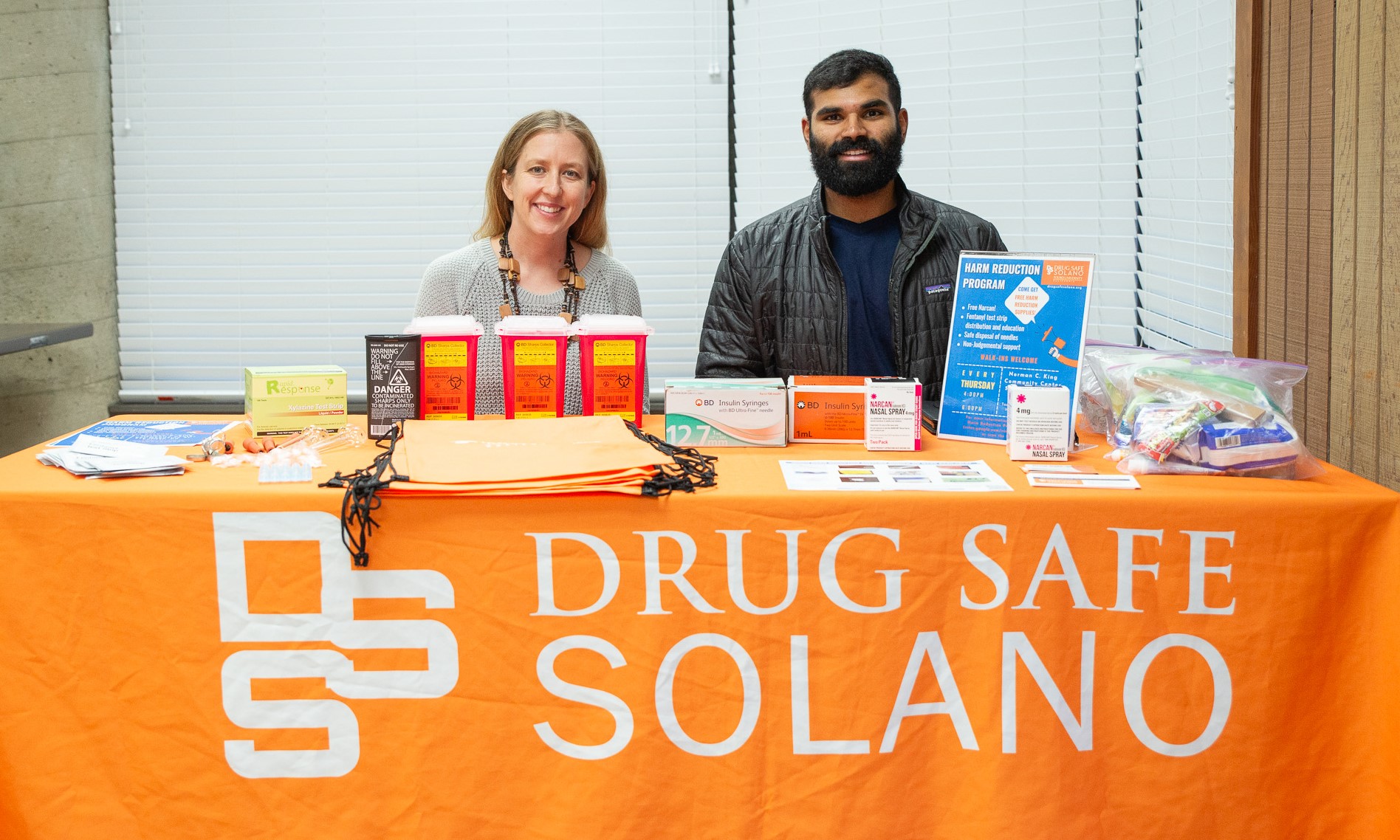Harm Reduction Redefines Compassionate Care
The Touro University California (TUC) student run initiative helps reduce disease in the community while instilling real world understanding of the drug crisis in future health care leaders.

It’s hard to miss the bright orange tablecloth of the Harm Reduction program when walking into the Student Run Free Clinic (SRFC).
It’s a project within Drug Safe Solano, the opioid coalition of which TUC is the fiscal agent. The table is carefully arranged with a wide scope of pharmaceutical objects that are the core for disease intervention. The items range from needles, tourniquets, and used needle disposal bins to glass pipes, fentanyl testing kits, and overloaded zip lock bags filled with hygiene and first aid basics. The program is designed to offer clean supplies to people who use drugs to minimize the spread of diseases like HIV and Hepatitis C and prevent as many overdose deaths as possible.
The Harm Reduction program was started and led by Dr. Christina Kinnevey-Greig who is also a chair on Drug Safe Solano. Coordinated by Destany Habte Michael, the venture is a comprehensive project designed to address substance use issues within Solano County. Recognizing the pressing need for initiatives like a needle exchange service, the program operates on foundational principles of meeting individuals struggling with substance use disorders where they are, without judgment, aiming to build trust and rapport. The hope is that as Harm Reduction becomes a trusted resource, they can be coaxed into an addiction recovery program when they are able.
“I think we recognized the need for a harm reduction program pretty early on when I started at Touro, but it was challenging,” says Kinnevey-Greig, who launched the program in October of 2022 after jumping over many hurdles. “My goal is to still get an official coalition run syringe exchange, but right now we’re under a physician led program.”
The Drug Safe Solano coalition is made up of over 200 members that includes representation from law enforcement, the county probation department, physicians, nurses, partnership health plan, public health, and the Solano County school districts. The coalition has four committees, each focused on a different aspect of the opioid epidemic.
“We have the medication assisted treatment expansion committee trying to figure out how we can reduce barriers to getting people access to medication assisted treatment and encourage our providers to prescribe that lifesaving medicine,” says Kinnevey-Greig. “The education group focuses on prevention and community gatherings, town halls, and other events as a voice for substance use disorder, prevention, and education. The data and sustainability group tracks overdoses, finds where the greatest needs are, and analyzes ways to improve Drug Safe Solano. Lastly, the Narcan expansion group ensures that as many organizations, groups, and locations as possible carry Narcan and are trained on how to use it.”
Central to the program’s success is its emphasis on building community relationships beyond merely supplying goods and working with groups outside of Drug Safe Solano. Collaborations with individuals and organizations, reciprocal support, and efforts to establish trust are pivotal in the program’s approach. This is where Habte Michael has been instrumental in building relationships to help with distribution, but also acquiring surplus items from business like first aid kits, food, and hygiene goods to offer patrons.
The program includes extensive community outreach efforts that involve direct engagement with vulnerable populations in locations such as encampments and shelters, and strong collaborations with entities like the Street Medicine Club, a TUC student group that addresses the complex medical needs of the unhoused population by visiting encampments.
“As things change, I think it’s really important to have coalitions like Drug Safe Solano, and people on the ground doing this work, because it keeps people in the loop of what’s going on,” says Habte Michael of how valuable that first-hand experience is. “Understanding what new substances are trending right now, and what people don’t know, or misconceptions is important. I’ve built some relationships with folks, and they’ve let me know that most of the time, it’s taking four to five Narcan units to bring someone back from an overdose. Having that connection and having somebody who can tell us what’s going on in the community informs our practice.”
Harm Reduction is a student run program, which includes Habte Michael, who is enrolled in TUC’s Master of Science in Medical Health Sciences curriculum. The program’s student-led nature brings advantages, such as diverse perspectives and commitment. Habte Michael invites more students to participate in the Harm Reduction program and emphasizes the ease of involvement and the substantial impact it can have. She highlights the transformative nature of participation for both individuals and the community at large.
“We require no prerequisites from TUC students who want to participate, no prior experience, just complete the training that we provide, and come with an open mind and respect,” says Habte Michael. “I hope more students come along, and that they can see that it’s really just showing up for others.”
